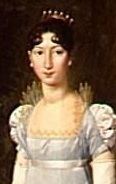Name Charlotte Gabrielli | ||
 | ||
Born 22 February 1795Saint-Maximin-la-Sainte-Baume ( 1795-02-22 ) Parents Christine Boyer, Lucien Bonaparte Grandparents Letizia Ramolino, Carlo Buonaparte Cousins Napoleon III, Napoleon II, Eugene de Beauharnais, Napoleon Louis Bonaparte, Charles Leon Similar People Lucien Bonaparte, Charlotte Bonaparte, Alexandrine de Bleschamp, Pierre Napoleon Bonaparte, Letizia Ramolino | ||
Charlotte bonaparte gabrielli
Filistine Charlotte Bonaparte (22 February 1795 - 13 May 1865) was a French Napoleonic princess and the eldest daughter of Lucien Bonaparte and Christine Boyer. She became princess Gabrielli following her marriage to Mario Gabrielli, prince of Prossedi and Roccasecca, duke of Pisterzo. In Italy she was known as Carlotta.
Contents
Biography
She was born at Saint-Maximin-la-Sainte-Baume, the daughter of Lucien Bonaparte (1775–1840), the first prince of Canino and Musignano, and his first wife Christine Boyer (1773–1800), herself the daughter of Pierre Boyer. She was the granddaughter of Carlo Buonaparte and his wife Letizia Ramolino, and the niece of the emperor Napoleon I. Her paternal grandmother, Letizia Ramolino (Madame Mère) nicknamed her "Lolotte". She spent her childhood in France and Spain and from 1804 onwards was educated by nuns in Italy.
Early marriage arrangements to the Spanish prince Ferdinando of the Asturias (later Ferdinand VII of Spain) and the grand-duke of Wurzburg (later Ferdinand III of Tuscany) were planned for her by Napoleon but eventually not concluded. When in 1809 Napoleon divorced his wife Joséphine de Beauharnais, the possibility that he might marry Charlotte was taken into consideration, as this would have consolidated family power. Charlotte was thus sent to live with her grandmother (Napoleon's mother, Madame Mère) in Paris in March 1810; eventually however the emperor did not favour a marriage with his niece. As a consequence of the increasingly abrasive relationship between Lucien and Napoleon, in August 1810 Charlotte, her father, stepmother Alexandrine de Bleschamps, siblings and household attempted to sail to the United States, but were captured by the British and forced to reside in England until the fall of Napoleon (1814).
During the restoration of her uncle Napoleon in the Hundred Days, Charlotte was granted the title of French princess (22 March 1815) and the qualification of Imperial Highness. Charlotte was then married on 27 December 1815 to the Roman prince Mario Gabrielli (1773 – 1841): he was the scion of an old Italian Catholic family from Gubbio, the son of the Napoleonic deputy mayor of Rome and nephew of a former Cardinal Secretary of State; she thus became the Princess Gabrielli until his death in 1841.
An outspoken and undevious woman, the Italians referred to Princess Gabrielli as "a true Bonaparte". Her private correspondence was full of gossip on the Imperial court in Paris, and her own behaviour in society was sometimes a source of concern for the French Imperial family. Nevertheless, even after the fall of Napoleon, she always remained loyal to her uncle's memory, and had a particular affection for her paternal grandmother Madame Mère to whom she remained attached until her death at Palazzo Bonaparte-d'Aste, in the Roman Piazza Venezia, in 1836.
She was an avid book collector and the patroness of a literary and intellectual circle that regularly met at her husband's villa on the Janiculum in the years 1820-1840. The "Villa Gabrielli al Gianicolo" was one of the must-see stops of Grand Tour travellers in reason of the magnificent view on the city, and is nowadays the Roman headquarters of the Pontifical North American College.
Charlotte survived her husband as the Dowager Princess Gabrielli (1841–1865) and the following year she quietly remarried to her faithful admirer the Cavaliere Settimio Centamori. With the rise of Emperor Napoleon III Charlotte was again officially included in the Imperial family and recognized as Princesse Bonaparte with the qualification of Highness (21 February 1853). Princess Gabrielli died on 6 May 1865, aged seventy, at Palazzo Gabrielli in Rome.
Marriage and children
On 27 December 1815, in Rome, she married prince don Mario Gabrielli, prince of Prossedi (6 December 1773 – 17 September 1841), with whom she had eight children:
In 1842 she married chevalier Settimio Centamori (1812 - 1889). The marriage was childless.
Portraits
She was represented by the French painter Jean-Baptiste Wicar as a young peasant woman in a life-size portrait, today in the collections of the Napoleonic Museum in Rome. Another life-size portrait by Jean-Pierre Granger is at the Palace of Versailles.
